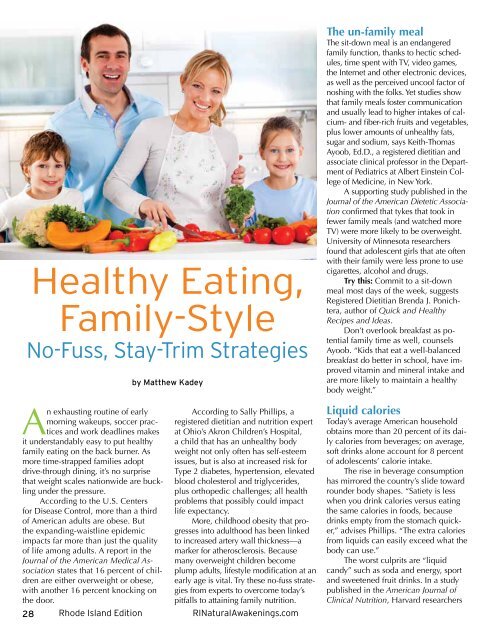<strong>Health</strong>y Eating,<strong>Family</strong>-StyleNo-Fuss, Stay-Trim StrategiesAn exhausting routine of earlymorning wakeups, soccer practicesand work deadlines makesit understandably easy to put healthyfamily eating on the back burner. Asmore time-strapped families adoptdrive-through dining, it’s no surprisethat weight scales nationwide are bucklingunder the pressure.According to the U.S. Centersfor Disease Control, more than a thirdof American adults are obese. Butthe expanding-waistline epidemicimpacts far more than just the qualityof life among adults. A report in theJournal of the American Medical Associationstates that 16 percent of childrenare either overweight or obese,with another 16 percent knocking onthe door.by Matthew KadeyAccording to Sally Phillips, aregistered dietitian and nutrition expertat Ohio’s Akron Children’s Hospital,a child that has an unhealthy bodyweight not only often has self-esteemissues, but is also at increased risk forType 2 diabetes, hypertension, elevatedblood cholesterol and triglycerides,plus orthopedic challenges; all healthproblems that possibly could impactlife expectancy.More, childhood obesity that progressesinto adulthood has been linkedto increased artery wall thickness—amarker for atherosclerosis. Becausemany overweight children becomeplump adults, lifestyle modification at anearly age is vital. Try these no-fuss strategiesfrom experts to overcome today’spitfalls to attaining family nutrition.28 Rhode Island Edition RI<strong>Natural</strong><strong>Awakenings</strong>.comThe un-family mealThe sit-down meal is an endangeredfamily function, thanks to hectic schedules,time spent with TV, video games,the Internet and other electronic devices,as well as the perceived uncool factor ofnoshing with the folks. Yet studies showthat family meals foster communicationand usually lead to higher intakes of calcium-and fiber-rich fruits and vegetables,plus lower amounts of unhealthy fats,sugar and sodium, says Keith-ThomasAyoob, Ed.D., a registered dietitian andassociate clinical professor in the Departmentof Pediatrics at Albert Einstein Collegeof Medicine, in New York.A supporting study published in theJournal of the American Dietetic Associationconfirmed that tykes that took infewer family meals (and watched moreTV) were more likely to be overweight.University of Minnesota researchersfound that adolescent girls that ate oftenwith their family were less prone to usecigarettes, alcohol and drugs.Try this: Commit to a sit-downmeal most days of the week, suggestsRegistered Dietitian Brenda J. Ponichtera,author of Quick and <strong>Health</strong>yRecipes and Ideas.Don’t overlook breakfast as potentialfamily time as well, counselsAyoob. “Kids that eat a well-balancedbreakfast do better in school, have improvedvitamin and mineral intake andare more likely to maintain a healthybody weight.”Liquid caloriesToday’s average American householdobtains more than 20 percent of its dailycalories from beverages; on average,soft drinks alone account for 8 percentof adolescents’ calorie intake.The rise in beverage consumptionhas mirrored the country’s slide towardrounder body shapes. “Satiety is lesswhen you drink calories versus eatingthe same calories in foods, becausedrinks empty from the stomach quicker,”advises Phillips. “The extra caloriesfrom liquids can easily exceed what thebody can use.”The worst culprits are “liquidcandy” such as soda and energy, sportand sweetened fruit drinks. In a studypublished in the American Journal ofClinical Nutrition, Harvard researchers
confirmed that a greater intake of thesebeverages leads to weight gain in adultsand children. “Plus, most sweeteneddrinks don’t have much nutritional value,”says Ayoob. Although they containimportant vitamins, even fruit juices,such as orange, cranberry and apple,still pack a lot of concentrated sugars.Try this: Phillips recommends limitingempty-calorie sweetened beveragesand replacing them with unsweetenedchoices like low-fat milk, homemadeiced tea and filtered water jazzed upwith lemon or lime. Keep daily intake offruit juice between four to eight ounces,and focus on eating whole fruits, instead.“You can also freeze natural fruitjuice in ice-cube trays,” says Phillips.“Pop these into [a glass of] water fora hint of sweet flavor.” Send childrento school or camp with a reusable,BPA-free water container (stainless steelworks well) so they get in the aquadrinkinghabit. Also consider stockingthe fridge with refreshing, potassiumrichcoconut water.Chicken again?Never before has such a variety offoods been more readily available. Still,too many families fall into the trap ofpreparing the same familiar eats—likespaghetti, chicken, and peanut butterand jelly sandwiches on white bread—week in and week out.When children are repeatedlypresented with the same foods, theydon’t learn to appreciate new flavors andtextures, which reinforces a picky palateand a fear of unfamiliar dishes, saysAyoob. From a body weight standpoint,an article published in Science suggeststhat when the brain isn’t gratified byfood—which can happen when the familyeats roast chicken for the fourth timein the same week—people are morelikely to make midnight kitchen raidsand add to their total calorie intake.Try this: Once a week, have a newfood-of-the-weekmeal, featuring healthyingredients such as quinoa, lean bisonor kale, paired with family favorites, toencourage branching out. “Don’t throwin the towel if your child emphaticallyrefuses it at the start. Research showsthat it can take 10 or more times beforea new food is accepted by a finickyeater,” advises Phillips, a mother of two.She also suggests letting kids loosein the produce department to pick anew fresh item they are curious about,and then involving them in its preparation,so they are more likely to tryit. “Or, substitute a familiar food, likeapples, with pears,” Ayoob recommends.Snack attacksWith so much unhealthy snack foodmarketed toward kids, it’s easy foryoungsters to graze their way to a biggerwaistline.Findings shared by Italian universityresearchers in the Journal of PediatricGastroenterology and Nutrition specificallylink savory, energy-dense snackfoods with childhood obesity. The U.S.Department of Agriculture reports thatthe percentage of American childreneating three regular meals a day hasdecreased over the past 25 years, whileconsumption of high-calorie, snacktypefoods has gone up.“Unhealthy snacking can have animpact on academic performance, energylevels and weight,” Ayoob remarks.Try this: Don’t push the panic buttonif a child looks a little heavy whilehe or she is still growing, but it neverhurts to give the household pantry andfridge an overhaul.First, get rid of nutrient-devoidchips, cookies and soda. “Replace themwith healthier, portable fuel like nuts,baby carrots, low-fat string cheese andcottage cheese, yogurt and dried fruit,”suggests Ayoob. This does away with thegood-versus-bad food battle on the homefront.Ponichtera likes keeping a bowl ofvaricolored seasonal fruit on the counterfor when kids return home ravenous. Shealso recommends offering sliced veggiesand fruit with tasty and nutritious yogurt,guacamole or hummus dip, or makingafter-school smoothies, using frozenfruit, healthy, low-fat milk and yogurt.Because watching TV—includingcommercials extolling unhealthyfoods—provides prime opportunities formindless snacking (various studies linkexcess TV time with elevated body fat),consider pulling the plug after an hour.If snacking must be done in front of thetube, Ponichtera likes natural, unbutteredpopcorn, deeming it excellentbecause it’s whole-grain, low in caloriesand high in filling fiber.Meals in a hurryThe desire for something quick may bewhy half of total U.S. food expenditurestoday go to meals prepared outside thehome. Studies suggest that the morewe purchase fast food, the greater ourgirth. “This should come as no surprise,because what is often ordered is mostlyout-of-control portions, higher incalories, fat, sugar and salt, than whatwould be served at home,” says Ayoob.Even shunning the all-too-familiardrive-through for a smarter option couldpack on pounds. Researchers reportedin the Journal of Consumer Researchthat an individual is likely to underestimatethe calories in a meal marketedAchieveFlawless Skinwith the most innovativetechniques and products, exclusively atFresh Face Skincare Center inside Avalon.Have Your Skin Looking andFeeling its Best for Summer•Summer Skin Facial Treatment $45Mention this ad in <strong>Natural</strong> <strong>Awakenings</strong> and receive $5 00 off.1221 Reservoir Ave, Cranston401-944-4601 • FreshFaceSkinCare.net510 East Main Rd(at Rt 138 & 138a)Middletown, RI 02842M-F 9:30a-7pSat 9:30a-6p, Sun 11a-4p401-847-7480(fax) 401-848-9493NaturesGoodness@cox.net www.NaturesGoodnessRI.comnatural awakenings August 201229




